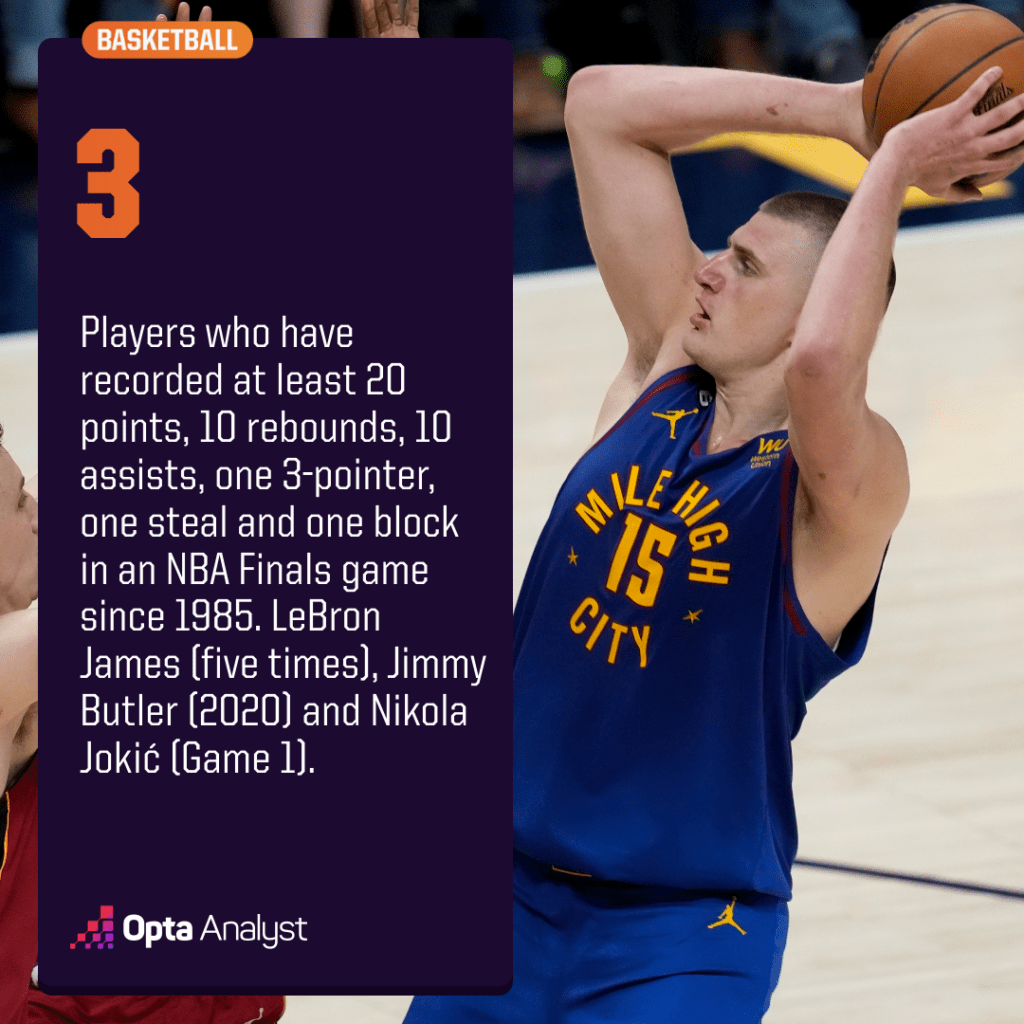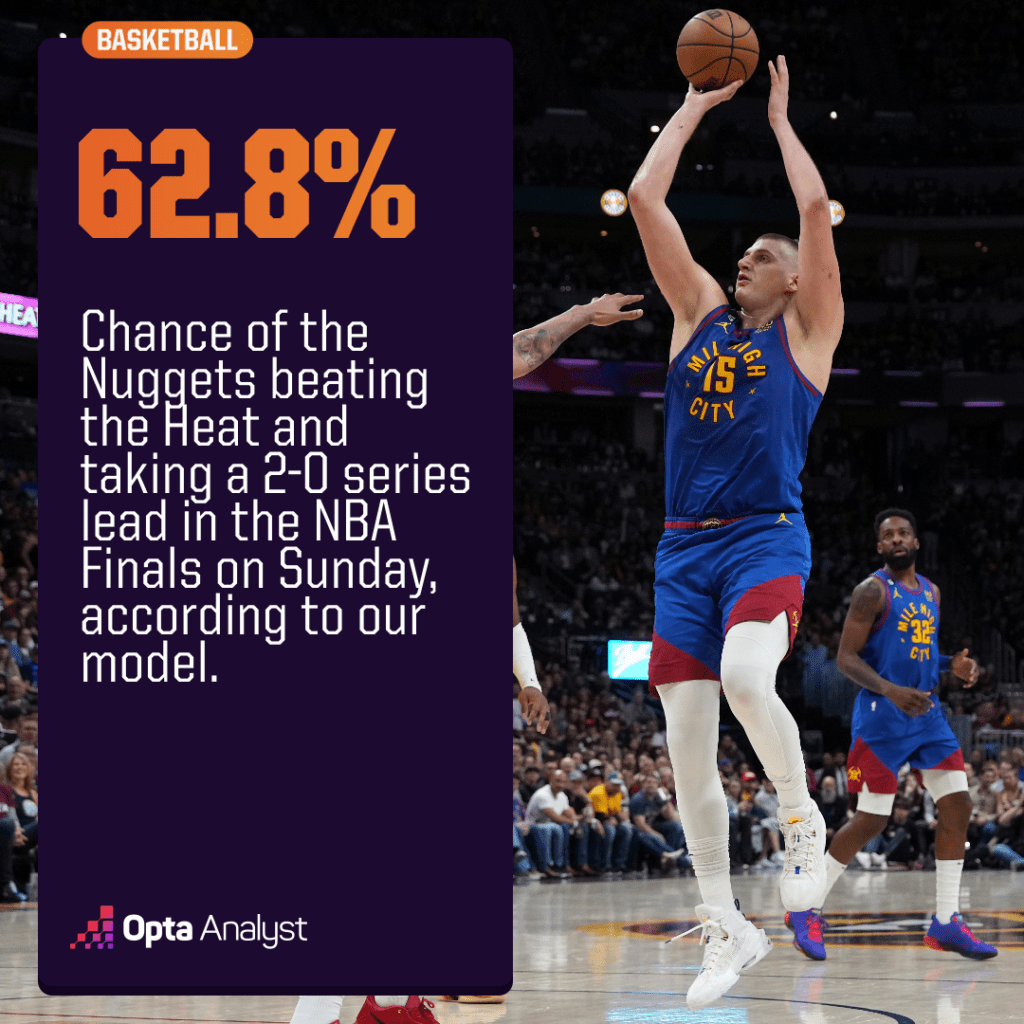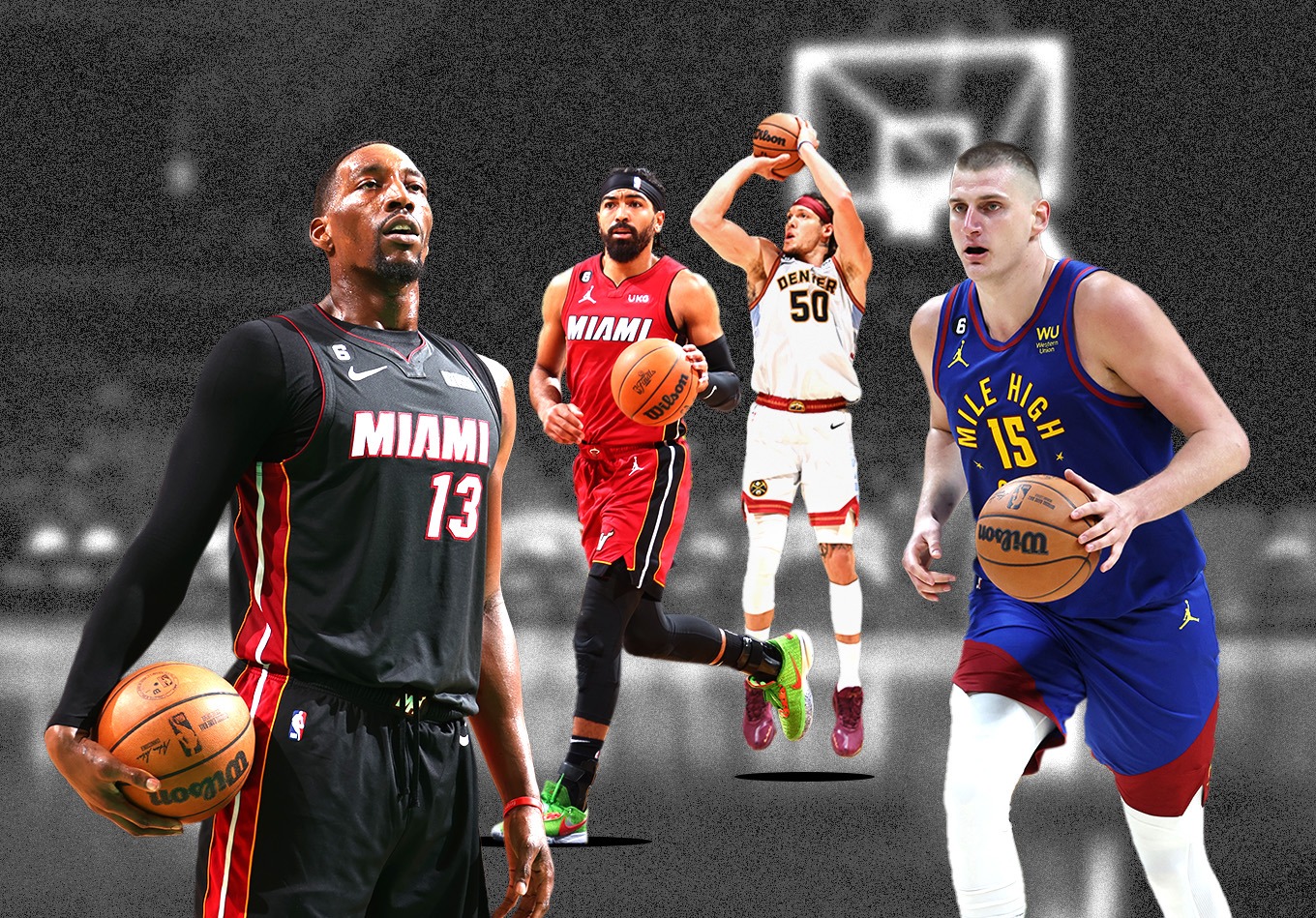Was this series over before it began? We break it all down and reveal our Heat vs. Nuggets win probability for Sunday’s rematch.
Outside of a couple of glimmers of life in the fourth quarter, the Denver Nuggets dominated the Miami Heat on both sides of the ball in Game 1 of the NBA Finals.
And their ringleader, Nikola Jokić, continued one of the greatest postseason runs of all time with 27 points, 14 assists, 10 rebounds, a block and a steal on 78.1% true shooting. The two-time MVP became just the second player in league history to rack up a triple-double in his Finals debut (the other being Jason Kidd).

How did Denver do it? Does Miami have any hope of striking back in Game 2 Sunday night on ABC, or was this series over before it even truly began?
Let’s find out.
How the Nuggets Did It
If we had to elucidate Denver’s dominance in Game 1 into three prongs, the first would likely be about the Nuggets’ size. Denver’s frontcourt of Jokić, Aaron Gordon, and Michael Porter Jr. is just so much bigger than most of Miami’s frontline combinations.
If this wasn’t clear just by looking at the lineups, it became immediately transparent in the first quarter when Gordon, the Joker’s partner-in-crime, practically mutilated the Heat for 12 points on 6-for-8 shooting.
- First Clip: Jamal Murray, who also filled the box score in his first NBA Finals game (26 points, 10 assists, six rebounds), has Gordon set a ball screen for him. Miami switches it, which puts Jimmy Butler (6-foot-7, 230 pounds) on Murray and Gabe Vincent (6’3 195 pounds) on Gordon (6’8 235 pounds). Murray enters the ball to Gordon in the post, and it looks like Denver is having baby back ribs for dinner.
- Second Clip: Gordon rushes down the court in transition to force a cross-match where Max Strus (6-foot-5, 215 pounds) is guarding him instead of Butler. He gets the ball again in the post, and you’ve seen this movie before.
- Third Clip: Gordon sets a down screen for Murray, Vincent gets caught in it because the Heat don’t want him to switch on Gordon, and it’s an easy layup for Murray.
Denver’s size on its own is a massive hurdle for the Eastern Conference champs to climb. The mountain becomes even more insurmountable when you factor in prong No. 2 – Denver’s patented two-man game between Murray and Jokić.
Remember last year’s Finals when we talked about how Stephen Curry had an answer for every pick-and-roll coverage the Boston Celtics threw at him? That was what happened with Jokić and Murray in Game 1.
For most of the game, the Heat tried to defend the action in a deep drop. When that happened, Murray was able to burn them with his pull-up jumper (first clip in the montage below). When Miami would send a second defender at Murray, he would take an extra dribble or two to lure the defending big man further away from Jokić and kick it to his big man for a pick-and-pop (second clip).
When a bigger defender was on Murray (like Butler or Haywood Highsmith), the Heat would try and switch the matchup. So Murray would just enter the ball into Jokić in the post, and he’d make mincemeat of the mismatch the same way Gordon did (third clip). Lastly, when Miami went to their zone, Murray would just find Jokić in the middle of the floor and let the greatest passing center of all time pick them apart from there (fourth clip).
In Game 1, it felt like no matter what Miami threw at Jokić and Murray, they had an answer. To make up the ground that Denver was gaining on offense, the Heat needed to fight fire with fire. Usually, that wouldn’t be too asinine of a request, considering Michael Malone’s club was just a middle-of-the-road defense in the regular season (14th in our adjusted defensive rating metric).
But alas, the Heat’s offense could do no right against prong No. 3: Denver’s defensive game plan. As they did against the Los Angeles Lakers, the Nuggets opted to protect the paint at all costs versus Miami.
As we’ve established before, the Nuggets don’t have many great paint protectors, so to safeguard the interior, they need to do so by flooding the restricted area with as many bodies as possible. The first step in doing this was having Jokić sag back in a deep drop to stay near the paint.
Unlike when Miami would use the drop against Murray/Jokić (see above), this worked for Denver because the Heat couldn’t burn them with pull-ups consistently enough. Bam Adebayo was 8 for 15 on jumpers between 4-15 feet on the way to a playoff-high 26 points, but as a team, the Heat were 11 for 35 (31.4%) on pull-up jumpers in Game 1 (per NBA.com).
The second step was having the Nuggets’ off-ball defenders help off of shooters to stay near the paint. Unlike the Lakers, Miami employs a handful of splendid marksmen. However, the Nuggets didn’t seem to care and would cheat off of them anyways. Miami couldn’t make them pay for most of the night, shooting just 13 for 39 for the game (33.3%).
Because Miami struggled on their pull-up jumpers and 3-pointers, the paint never got uncongested, and as a result, Denver held Miami to just 38 points in the paint (8.4 points less than its season average) and two free-throw attempts (21 less than its season average) for the entire game.
What Now for the Heat?
So, are the Nuggets just going to steamroll past the Heat en route to the first NBA title in franchise history? Not quite. After all, you don’t upset the top-seeded Milwaukee Bucks and second-seeded Celtics in an NBA playoff series if you don’t have a couple of moves up your sleeve.
For the Gordon dilemma, Erik Spoelstra’s solution could involve putting bigger defenders on Murray so that when Gordon tries to mismatch hunt, he’ll end up with someone he’s less likely to bully.
In this next clip, we see Denver again trying to use an off-ball screen from Gordon to free up Murray. However, this time, instead of trying to fight through the screen as Vincent did earlier, Highsmith late switches onto Gordon and gallantly bangs with him on the inside while Murray is forced to settle for a Butler-defended jumper.
At 6-foot-7, 220 pounds, Highsmith is a much better option than Vincent or Strus to have switched onto Gordon. The Heat got good minutes out of him in Game 1. Look to see a heavy dose of him in Game 2, especially if he’s continuing to hit his shots (he was 7 of 10 from the floor in Game 1).
You’re going to need to sit down to comprehend the other big adjustment Miami needs to make at Ball Arena in Game 2. The Heat are going to have to hit some shots after Strus (0 for 10), Duncan Robinson (1 for 6) and Caleb Martin (1 for 7) went a combined 2 for 23.
To open up the paint for Butler to attack and draw fouls (he had no free-throw attempts in Game 1), Miami needs to make Denver pay for sagging off its shooters and for playing its pick-and-roll ball handlers in a deep drop.
We started to see that in the fourth quarter (which, coincidentally, was their best quarter of the game). As a team, the Heat shot 6 for 12 from beyond the arc (after going 7 of 22 in the first three quarters). And Vincent and Kyle Lowry started making Denver pay for its drop coverage by draining jumpers, forcing Jokić to play screens higher up at the level.
Look what kind of difference it makes for Miami when it can force Jokić to do that:
As for the Murray/Jokić two-man game, all we can really say is Miami needs to keep showing them different looks and make life more difficult for them. If we had a better answer than that, we’d likely be employed by an NBA staff. Hell, even the people that work on NBA teams still can’t figure out how to slow that tandem down.
But when you’re playing in the NBA Finals, realistically, you can’t take away everything from your opponent. You just need to take enough pieces off the board to win four games before they do.
Game 2 Win Probability: Who Has the Edge?
Our win probability model calculates each team’s chances of winning (in this case, Game 2) based on thousands of simulations.
It incorporates our adjusted team ratings (including overall adjusted team rating, adjusted offensive rating, and adjusted defensive rating), accounts for recency bias (so it gives more weight to teams playing well), and for how well teams performed against other good teams.

For Sunday’s game in Denver, it gives the Nuggets a 62.8% probability of taking down the Heat and holding serve with a 2-0 lead as the series shifts to Miami.
But if Miami can figure out how to deal with Denver’s size while also hitting enough shots to unclog the paint, it may have just enough (don’t forget Tyler Herro is still waiting in the shadows) to pull off one last series upset.
Like this? Follow us on Twitter for more.
